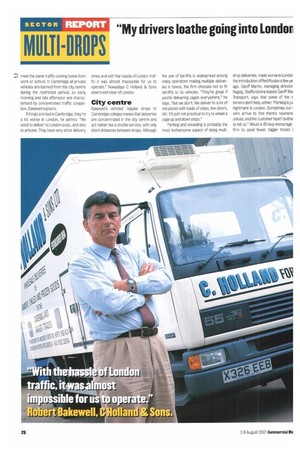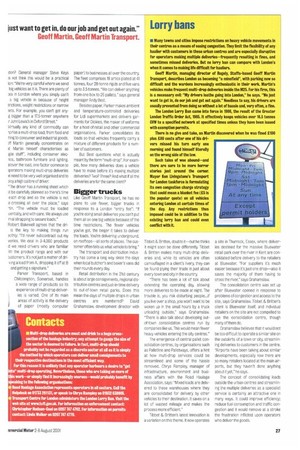T alk to operators whose work consists entirely of multi-drops in
Page 24

Page 26

Page 27

If you've noticed an error in this article please click here to report it so we can fix it.
urban centres and a realisation soon begins to dawn: there's an awful lot to be said for trunking goods up and down the motorway network day in and day out without the ever-present risk of parking fines, missed deadlines and the sheer aggro of gridlocked streets every working day.
London's lorry ban is notorious, but who can deny that something had to be done about traffic congestion? It's ironic, therefore, that the ban has not eased the congestion, as anybody who's tried driving along any of London's main trunk routes will know. Of course London is not the only city or town to introduce rigid restrictions on commercial vehicle movements—congestion is a problem for all road users and it's getting worse.
"The multi-drop sector is one that causes a lot of anguish," says Mike Farmer, regional director for the Midlands and West at the Road Haulage Association. "The problems faced by operators in this sector are immense."
When the first traffic wardens arrived on the streets in the mid-1960s they were greeted with a hostility that has endured to this day. But now they seem positively benign compared with the new breed of private-sector contractors patrolling the streets. "They're zealots," says one haulier. "They're on piece work so as soon as you stop the engine they pounce on you. Some parts of town are a virtual no-go area." The Greater London Authority's plan for a charge on every vehicle entering the city (probably per visit) will only add to the misery, but London's problems are hardly unique.
Bakery goods
Robert Bakewell runs a wholesale catering business, C Holland & Sons, based in Meldreth, near Cambridge. His firm runs a fleet of four 12-tonne temperature-controlled rigid box vans delivering bakery goods and other ingredients to clients across Cambridgeshire, Suffolk, Bedfordshire and Hertfordshire.
Naturally, a lot of his deliveries are made into the centre of Cambridge, including many of the university colleges, and congestion is a real headache. "We usually average about 14 deliveries per vehicle per day in Cambridge," he says. "But if the driver gets held up for any reason he might manage only five."
Cambridge, like so many cities, has its own vehicle restrictions designed to alleviate congestion in the main shopping areas during the day But according to Bakewell, the convenience of the shoppers has been bought at the expense ofjust about everybody else: "I have to open my warehouse earlier than I used to because since they introduced the lorry ban my drivers have to get in, do all their deliveries and get out of there by 10:00hrs.
"This means they're on the road at the same time as all the people driving in to work or driving their kids to school." It's no better when the ban ends at around 16:00hrs, Bakewell adds; then his vehicles P meet the same traffic coming home from work or school. In Cambridge all private vehicles are banned from the city centre during the restricted period, so early morning and late afternoon are characterised by concentrated traffic congestion, Bakewell explains.
If things are bad in Cambridge, they're a lot worse in London, he admits: "We used to deliver to London pubs, and also to prisons. They have very strict delivery times and with the hassle of London traffic it was almost impossible for us to operate." Nowadays C Holland & Sons steers well clear of London.
City centre
Bakeweil's vehicles regular drops to Cambridge colleges means that deliveries are concentrated in the city centre and act rather like a shuttle service, with only short distances between drops. Although the use of tail-lifts is widespread among many operators making multiple deliveries in towns, the firm chooses not to fit tail-lifts to its vehicles. "They're great if you're delivering cages everywhere," he says, 'but we don't. We deliver to a lot of old places with loads of steps, low doors, etc. It's just not practical to try to wheel a cage up and down steps."
Parking and unloading is probably the most bothersome aspect of doing multi
drop deliveries, made worse in London the introduction of Red Routes a few ye, ago. Geoff Martin, managing director flugely. Staffordshire-based Geoff Mal Transport, says that some of the c tomers don't help, either "Parking is jig nightmare in London. Sometimes our vers arrive to find there's nowhere unload, and the customer hasn't bothei to tell us." Would a £5 levy encourage firm to send fewer, bigger trucks i don? General manager Steve Keys s not think this would be a practical ion: 'We're very careful where we send big vehicles as it is. There are plenty of :es in London where you simply can't a big vehicle in because of height trictions, weight restrictions or narrow :ets. For example, you can't get anyg bigger than a 17.5-tonner anywhere .r John Lewis's in Oxford Street."
Virtually any kind of commodity can iprise a multi-drop load, from food and hing to consumer and industrial goods. )ff Martin generally concentrates on A Martin himself characterises as igile stuff", including consumer eleclies, bathroom furniture and lighting. atever the load, one factor common to Terators making multi-drop deliveries e need to be very well organised and to ploy a high calibre of driver.
"The driver has a running sheet which A be carefully planned so there's time each drop and so the vehicle is not is-crossing all over the place," says 'tin. "The vehicle must be loaded uentiat and with care. We always use rnal strapping to secure loads."
Robert Bakewell agrees that the driis the key to making things run )othly: Id never subcontract out my varies. We deal in 3-4,000 products d we need drivers who are familiar ith the product range and with our ustomers. It's not just a matter of driving a load from A, dropping ft off at 13 and getting a signature."
Parker Transport, based in Chilcompton, Somerset, handles a wide range of products so its experience of multi-drop deliveries is varied. One of fts main areas of activity is the delivery I, of paper (mostly computer paper) to businesses all over the country. The fleet comprises 19 artics plated at 41 tonnes, four 28-tonne rigids and five vans up to 3.5 tonnes. "We car deliver anything from one box to 26 pallets." says general manager Andy Best.
Besides paper, Parker makes ambient and temperature-controlled deliveries for Lidl supermarkets and delivers garments for Dickies, the maker of uniforms for a host of retail and other commercial organisations. Parker consolidates its loads so that vehicles frequently carry a mixture of different products for a number of customers.
But Best questions what is actually meant by the term "mufti-drop". For example, how many deliveries does a vehicle have to make before it's making multiple deliveries? Two? Three? And what if all the deliveries are for the same client?
Bigger trucks
Like Geoff Martin Transport, he has no plans to use fewer, bigger trucks in response to a London "entry fee": "If you're doing small deliveries you can't put them all on one big vehicle because of the time restrictions. The fewer vehicles you've got, the longer it takes to deliver the loads. You're delivering underground, on rooftops—all sorts of places. The customer often tells us what vehicle to bring."
The transport and distribution industry has come a long way since the days when local butcher's and baker's vans did their rounds every day.
Retail distribution in the 21st century is about large consignments, regional distribution centres and just-in-time delivery to out-of-town retail parks. Does this mean the days of multiple drops in urban centres are numbered? David Grahamslaw, development director with Tibbet & Britten, doubts it—but he thinks it might soon be done differently. Tibbet & Britten makes many multi-drop deliveries and, while its vehicles are often camouflaged in a client's livery, they can be found plying their trade in just about every town and city in the country.
"There has been a lot of talk about extending the operating day, allowing more deliveries to be made at night. The trouble is, you risk disturbing people...if you live over a shop, you won't want to be woken up in the small hours by a truck unloading outside," says Grahamslaw. "There is also talk about developing outof-town consolidation centres run by companies like us. This would mean fewer heavy vehicles entering the cfty centres."
The emergence of central pallet consolidation centres, by organisations such as Palletline and Palletways, offers a hint at how multi-drop services could be streamlined and some of the hassle removed. Chrys Rampiey, manager of infrastructure, environment and business affairs with the Road Haulage Association, says: "Mixed loads are delivered to these warehouses where they are consolidated for delivery by other vehicles to their destination. It saves on a lot of wasted mileage and makes the process more efficient" Tibbet & Britten's latest innovation is a variation on this theme. It now operates a site in Thurrock, Essex, where deliveries destined for the massive Bluewater retail park over the river in Kent are consolidated before delivery to the retailers at Bluewater. "For suppliers it's much easier because it's just one drop—also it saves the majority of them having to cross the river," says Grahamslaw.
The consolidation centre was set up after Bluewater opened in response to problems of congestion and access to the site, says Grahamslaw, Tibbet & Britten's client is Bluewater itself, and individual retailers on the site are not compelled to use the consolidation centre, though many of them do.
Grahamslaw believes that it would not be too difficult to operate a similar site or the outskirts of a town or city, streamlining deliveries to customers in the centre. "Airports have been talking about similar developments, especially now there are so many retailers located at the main airports, but they haven't done anything about it yet," he says.
The concept of consolidating loads outside the urban centres and streamlining the multiple deliveries as a specialist service is certainly an attractive one in many ways. It could improve efficiency; reduce fuel consumption and traffic congestion and it would remove at a stroke the frustration inflicted upon operators who deliver the goods.




















































































































